by Lisa Cooke | Aug 27, 2015 | 01 What's New, Ancestry, DNA, images, Trees
A new tool at Ancestry DNA is blowing my genealogy mysteries wide open!
is blowing my genealogy mysteries wide open!

I have been up since 5:30 with plenty of goals and ambitions for today. But I got distracted. Distracted by a new tool at AncestryDNA that is blowing my genealogy mysteries wide open.
The new tool AncestryDNA Common Matches tool is hiding between the “Pedigrees and Surnames” filter and the “Map and Locations” filter on your matches’ main match page. The Common Matches tool pulls out the shared 4th cousin or higher matches between two people.
Let’s take a look at how this might work for you.
 Let’s say you have a second cousin, Denise, that you have already identified in the Ancestry database and you know your common ancestral couple is Joseph and Louise Mitchell. You want to gather others who share DNA with both you and Denise. Those individuals then have a high likelihood of being related to Joseph and Louise in some way.
Let’s say you have a second cousin, Denise, that you have already identified in the Ancestry database and you know your common ancestral couple is Joseph and Louise Mitchell. You want to gather others who share DNA with both you and Denise. Those individuals then have a high likelihood of being related to Joseph and Louise in some way.
So we click on the “Shared Matches” button on Denise’s page and find that Mike, Spencer, and Wendy all have DNA in common with you and Denise. After reviewing pedigree charts, you are able to determine that Mike is related through Louise’s sister and Wendy is related through Joseph’s brother. Note that Wendy’s actual relationship to you is not 4th cousin, as it is shown, but she is actually your 3rd cousin once removed. Remember that the relationship given is not always the exact relationship of two people who have been tested.
 But what about Spencer? Spencer, unfortunately has not yet linked his family tree to his Ancestry account or answered any of your queries about his family tree. I am sure he has just been busy. Or he doesn’t know his family tree. Or his computer was captured by aliens or smashed by his two-year-old grandson just as he was about to click “send” and reveal how the two of you were connected. Whatever the case may be, up until this point you haven’t heard a peep from Spencer and therefore had absolutely no way to figure out how Spencer was related to you.
But what about Spencer? Spencer, unfortunately has not yet linked his family tree to his Ancestry account or answered any of your queries about his family tree. I am sure he has just been busy. Or he doesn’t know his family tree. Or his computer was captured by aliens or smashed by his two-year-old grandson just as he was about to click “send” and reveal how the two of you were connected. Whatever the case may be, up until this point you haven’t heard a peep from Spencer and therefore had absolutely no way to figure out how Spencer was related to you.
But now you know that he is somehow associated with the Joseph and Louise Mitchell family because he came up as In Common With (ICW) you and Denise.
We can take this one step further and ask Ancestry to show us who has DNA ICW you and Spencer. You can see here that while Mike still remains, Wendy has dropped off the list. Now there are two possible explanations for this: The first is that Spencer is related through Louise’s parents, John and Sarah, and that is why he is not sharing DNA with Wendy.
The other, less likely, possibility is that Spencer is related through Joseph’s parents Louis and Mary, but doesn’t share enough DNA with Wendy to be detected on this test.
While this information is helpful, it still hasn’t completely solved the case. The first thing you should do with your new-found knowledge is start sending more pointed questions to your matches. Here is an example message you might send to Spencer:
“Dear Spencer,
I was just playing around with the new AncestryDNA Common Matches tool and I see that you are related to a few of my other matches that connect through Joseph and Louise Mitchell. Louise’s parents, John and Sarah Marsh, were both born in Mississippi in the 1840’s and Joseph’s parents Joseph and Mary Mitchell, were born in Tennessee in 1856 and 1863 respectively.
Do any of these names or places sound familiar to you?
I am looking forward to working with you on this connection.
Your DNA Cousin, Diahan”
Assuming this garners a response, you can then work together to find your connection. If his budget is not allowing for a new computer at this time and you never hear from Spencer, the key to figuring out how he is related to you may be in the new match, Beth, who is ICW you and Spencer. If you can figure out how Beth is related to you, you will know Spencer is related in a similar way.
 If you’ve decided you would like to get in the DNA game, start with Ancestry DNA: Genetic Testing – DNA Test
If you’ve decided you would like to get in the DNA game, start with Ancestry DNA: Genetic Testing – DNA Test , and then head over to AncestryDNA and start growing your genetic family tree!
, and then head over to AncestryDNA and start growing your genetic family tree!
For a little more guidance, I suggest you purchase my laminated quick guides, “Understanding AncestryDNA and “Understanding Family Tree DNA.” These are also available as a part of a complete bundle of DNA guides specifically designed to help you navigate your results at the leading genetic genealogy testing companies. Click here to see all our DNA quick guides.
by Lisa Cooke | Jun 25, 2015 | 01 What's New, Ancestry, DNA, images, Listeners & Readers
 Opening your AncestryDNA account to find a New Ancestor Discovery can be a bit like the experience my nine-year old had at the beach today. He noticed something unusual in the sand on his way down to the beach and excitedly used his hands to unearth the treasure. However, it turned out to be a Captain Hook figurine long lost by another (likely much younger) beach-goer. His initial excitement quickly dissipated. He was disappointed as he had clearly found something he did not need or want.
Opening your AncestryDNA account to find a New Ancestor Discovery can be a bit like the experience my nine-year old had at the beach today. He noticed something unusual in the sand on his way down to the beach and excitedly used his hands to unearth the treasure. However, it turned out to be a Captain Hook figurine long lost by another (likely much younger) beach-goer. His initial excitement quickly dissipated. He was disappointed as he had clearly found something he did not need or want.
I have heard from many of you that are confused and disappointed with Ancestry’s attempts to merge your genetics and your genealogy. Keep in mind that AncestryDNA matches are only using your genetics. Your DNA Circles and your New Ancestor Discoveries incorporate your linked tree into your genetic test results.
 Lisa recently forwarded me a comment from Kate that perfectly illustrates the confusion I’m talking about. “We had DNA done thru Ancestry,” she writes. “The results [have] made me seriously question what they are showing me. I believe they are using my tree to show me results that are more vague than they are revealing. The latest example they show is a person not related by blood. This family is related by name only (my uncle’s spouse).
Lisa recently forwarded me a comment from Kate that perfectly illustrates the confusion I’m talking about. “We had DNA done thru Ancestry,” she writes. “The results [have] made me seriously question what they are showing me. I believe they are using my tree to show me results that are more vague than they are revealing. The latest example they show is a person not related by blood. This family is related by name only (my uncle’s spouse).
“My results from Ancestry show that they use my tree to make matches. Just checked the web page for DNA results. They show numerous matches….Three or 4 contacted me because they were convinced they were related by blood when they may have had a remote tree connection. They contacted me because the DNA results showed they were a 3rd or 4th
cousin, when in fact they would only be a 3rd or 4th cousin in my tree.”
I can see why she’s confused. First, let’s review what an AncestryDNA New Ancestor Discovery (NAD) actually IS. NAD’s are based on the DNA Circle idea created by Ancestry. Remember that a DNA circle is when Ancestry can identify a shared genetic AND genealogical connection between three or more people. Using various standards and measures, they name an ancestor as your connection. This is the ancestor I affectionately call our Party Host. This is the ancestor who passed his or her DNA down to all of their descendants, like tickets inviting them to this party in the future. So, everyone who holds a ticket, AND who has honored that party host ancestor by placing their name in their pedigree chart, is listed as a guest in the form of a DNA circle connection. (Click here to read a blog post about this concept.)
The New Ancestor Discoveries just take that one step further. The NAD is an attempt to find ticket holders who have not yet taken that extra step and added that important Party Host ancestor to their family tree. The NAD is like a nudge, inviting us to double check our family tree to see if this particular ancestor might need to be added. It is important to remember that a NAD comes only after a DNA circle has already been formed, and there could have been errors in that formation. So the very first thing you need to do with a NAD is to correspond with circle members and double check that the Party Host of the circle, their common ancestor, is correct. Then we can move on to evaluating the NAD.
Ancestry admits on its help pages that there are three reasons why you might get an NAD, and only one is “right” in the way you and I might view it.
 The “right” answer comes when the DNA circle was drawn correctly, the Party Host properly identified, and your DNA connection is strong to two or more members of the circle. You are then able to verify through traditional genealogical methods that you are an actual descendant of the Party Host, holding that coveted ticket, shown in blue in this modified image from the AncestryDNA help page.
The “right” answer comes when the DNA circle was drawn correctly, the Party Host properly identified, and your DNA connection is strong to two or more members of the circle. You are then able to verify through traditional genealogical methods that you are an actual descendant of the Party Host, holding that coveted ticket, shown in blue in this modified image from the AncestryDNA help page.
There are two other alternatives.
 First, you are related to the NAD Party Host (the New Ancestor that was discovered) via marriage. In this second example from Ancestry’s help page, we see that your ancestor was married twice. The members of the DNA circle are descendants of her other marriage. Remember, that you do not share DNA with every member of the DNA circle. In this case, you share the purple DNA with a few members of the circle. But there are other members that share the blue. So the super computers at Ancestry first put all the blues together in a circle with the Party Host at the top. Then you come along with purple DNA that matches a few in the circle and their supercomputer erroneously assumes that you too must have been invited to this “blue” party, but in fact, the blue/purple members of the circle are double booked. They have been invited to both the blue and the purple party.
First, you are related to the NAD Party Host (the New Ancestor that was discovered) via marriage. In this second example from Ancestry’s help page, we see that your ancestor was married twice. The members of the DNA circle are descendants of her other marriage. Remember, that you do not share DNA with every member of the DNA circle. In this case, you share the purple DNA with a few members of the circle. But there are other members that share the blue. So the super computers at Ancestry first put all the blues together in a circle with the Party Host at the top. Then you come along with purple DNA that matches a few in the circle and their supercomputer erroneously assumes that you too must have been invited to this “blue” party, but in fact, the blue/purple members of the circle are double booked. They have been invited to both the blue and the purple party.
How can you fix this? If you can identify your purple Party Host, then you can add that person to your tree, and the trees of your DNA matches and likely then a new DNA Circle will form with the purple Party Host at its head, and the blue NAD will disappear.
 The other situation that many of you are seeing, especially those of you with ancestry from small communities, is demonstrated in Figure 3 of the Ancestry Help page, reproduced here. As you can see, this one is much more complicated. (In fact, the colors I added aren’t even quite accurate, as not all descendants of the blue NAD have the same blue, but rather different shades of blue depending on the segment they received- but this is a story for another post!)
The other situation that many of you are seeing, especially those of you with ancestry from small communities, is demonstrated in Figure 3 of the Ancestry Help page, reproduced here. As you can see, this one is much more complicated. (In fact, the colors I added aren’t even quite accurate, as not all descendants of the blue NAD have the same blue, but rather different shades of blue depending on the segment they received- but this is a story for another post!)
The short of it is, the members of the previously established DNA circle share one single ancestor with each other, but they share multiple separate and distinct ancestors with you. Looking at this chart it seems very clear, but remember, in the database we only see you and the people you match. We cannot tell from the DNA shared which piece came from which ancestor. So, it is very important to check and double check the pedigrees of those in the circle to identify additional shared lines.
The short of it is, these NAD’s are following the guilt by association rule, but in fact, you could be innocent. Just keep in mind the simple principle that you DO share a common ancestor with those members of the circle that you share DNA with. You do NOT necessarily share common ancestry with those in the circle that you do not share DNA with.
The key is to take these NAD’s for what they really are: research suggestions. Keep your expectations low, and then you will be pleasantly surprised when you are able to verify a connection.
 Ready to learn more about DNA testing for family history? Click here to watch two video interviews in which Lisa and I chat about genetic genealogy.
Ready to learn more about DNA testing for family history? Click here to watch two video interviews in which Lisa and I chat about genetic genealogy.
My DNA quick reference guides can get you started on your own DNA research, or help you unpuzzle and maximize results you don’t fully understand. Click here to see all six guides: purchase them individually or as value-priced bundles.
by Lisa Cooke | Jun 8, 2015 | 01 What's New, Ancestry, Australian, DNA, images
 AncestryDNA test kits are now available to purchase in Australia and New Zealand, according to a recent statement from Ancestry. These two countries join the UK, Ireland and the US in having access to AncestryDNA’s popular autosomal kits.
AncestryDNA test kits are now available to purchase in Australia and New Zealand, according to a recent statement from Ancestry. These two countries join the UK, Ireland and the US in having access to AncestryDNA’s popular autosomal kits.
DNA testing for genetic reasons isn’t new Down Under. Your DNA Guide Diane Southard blogged on our site last fall about a National Genographic Project that looked at the mixture of genes among residents of Wellington, New Zealand. They determined that “the original Polynesian population and a small East Asian population are certainly the minority among a predominately Western European population group.”
Additionally, Family Tree DNA has a New Zealand DNA Project that anyone with NZ roots can join. It has three DNA groups for Australia: one for adoptees, one for descendants of settlers and one specifically for descendants of early buy medication for depression online convicts (Australia was originally a British penal colony). So AncestryDNA in Australia and New Zealand represents just one more option for this part of the world.
 Have you had your DNA tested yet for genealogy? Have you found the results to be meaningful or useful? Diahan Southard is Genealogy Gems’ resident DNA expert. Watch for her posts here that keep up with exciting developments in genetic genealogy and teach you how to use it properly!
Have you had your DNA tested yet for genealogy? Have you found the results to be meaningful or useful? Diahan Southard is Genealogy Gems’ resident DNA expert. Watch for her posts here that keep up with exciting developments in genetic genealogy and teach you how to use it properly!
Her series of DNA quick guides can get you started on your DNA path and help you navigate your results at Family Tree DNA or AncestryDNA. Grab just the ones you need or the full bundle for a value price!
by Lisa Cooke | Apr 29, 2015 | 01 What's New, Ancestry, DNA, images, Trees
 The ideal genetic genealogy interface creates a seamless transition between genetics technology and genealogical research findings. Most currently available tools are either DNA technology without much genealogy, or genealogy without much DNA technology. AncestryDNA is really pioneering the genetic and genealogical integration with its newest AncestryDNA product update.
The ideal genetic genealogy interface creates a seamless transition between genetics technology and genealogical research findings. Most currently available tools are either DNA technology without much genealogy, or genealogy without much DNA technology. AncestryDNA is really pioneering the genetic and genealogical integration with its newest AncestryDNA product update.
The goal of genetic genealogy is to aid your traditional research by verifying known connections and providing clues to as yet unknown ancestors. DNA was never meant to replace traditional research methods, nor has it ever claimed that ability. Rather, it is meant to aid your traditional research by verifying known connections and providing clues to as-yet unknown ancestors.
I admit, I dream of a future technology so precise that it pinpoints the locations of ancestors and defines our exact relationships to others. While we are not there yet, many have experienced a genetic test’s power to obliterate previously-held beliefs about relationship and heritage, and create new intricate and personal relationships where before there were only blank spaces. In this sense, genetic genealogy can be viewed as a kind of police force of the genealogy world, righting wrongs and taking names. But I digress.
For now, the ideal must remain a seamless transition between genetics technology and traditional research results, so that the two so completely complement each other that we can’t see where one stops and the other begins. Yet the two worlds are often separated by a chasm of misunderstanding and just plain ignorance. Of the three testing companies, two are making mediocre efforts at best to try to help you incorporate your genetics into your genealogy. They are basically dishing out a serving of genetics, offering a vending machine of genealogy snacks and calling it a full meal.
With one exception.
AncestryDNA has put genetic and genealogical integration at the forefront of its product. They are the only company making a serious effort to integrate your genetics and your genealogy. To be successful, they need two things: tons of people and their genealogy. The more people test, the better the database becomes. Not just in terms of the matches you find, but also in terms of statistics and the power that numbers have to solve complex problems, like relatedness.
So, how do they get more people interested in genetic genealogy?
This reminds me of my early days at Relative Genetics, one of the first genetic genealogy companies. I was fresh out of college and tasked with training our CEO, CFO, QA director, and marketing director about what exactly it was that we did as a genetic genealogy company. None of these men had any experience in genetics or genealogy. In those meetings as we were trying to figure out ways to grow our company in an unknown industry, I felt like I was the constant downer to the party. As a scientist I had been trained that there are no absolutes. Whenever we talk about outcomes it is always in terms of “most likely” or “less likely” and to never, ever say “always.” So when they would get excited about an idea and propose wording for an ad campaign, I was always reining them in.
After reading a recent announcement by AncestryDNA, I feel like their marketing department had a meeting on the day their scientific advisor was out sick and without his or her corralling, they started a stampede.
Which, of course, was exactly what they wanted.
In their press release, Ancestry’s Dr. Ken Chahine, SVP and GM of AncestryDNA said, “It is effectively a shortcut through time—you take the test today and we tell you who your ancestors were, for example, in the 1700s. You don’t need to research records or build a family tree — AncestryDNA now transports you to the past.”
Which is exactly what people want to hear, especially non-genealogists who are curious about their past, but don’t have the tools or know-how or interest in doing the actual genealogy work.
But is it true? Is genetic genealogy a short cut through time?
“Absolutely,” says the marketing team.
“Sometimes, and that depends on factor A, and factor B and situation C and…” say the scientists.
And they are both right. The trick is to hear them both as you review these kinds of new advances in genetic genealogy.
What makes the “absolutely” true is that one of the dreams of genetic genealogy is to use the DNA of living people today to actually reconstruct the genetics of our ancestors. So that their actual DNA profile is known. Then it will be easy to identify their descendants as we will be able to see immediately what part of our DNA came from which of our ancestors. Ancestry has demonstrated their ability to do this in a large scale study of the descendants of a 19th-century American and his two successive wives.
Now, time for the “Sometimes.” This full genome reconstruction hasn’t been done yet for your grandparents, or great grandparents. Right now the best we can do is use your DNA to link you to living individuals, then rely on your traditional genealogy to help you find your common ancestor. Ancestry is trying to help you do that using their DNA circles, and now with their New Ancestor Discoveries.
Remember that to be included in a DNA circle you have to have a “ticket” to the party, meaning both your genetics and your genealogy match with at least two other people in the database and a circle is created around the host of the party, who is your common ancestor.
With New Ancestor Discoveries, we are letting those with just a genetic ticket into the party. Meaning that if you share DNA with two or more people in a DNA Circle, the host of that circle is named as an ancestor who might be on your pedigree chart.
Did you notice how I said “might?” That this newly discovered ancestor MIGHT be in your pedigree chart?
As an idea, New Ancestor Discoveries is VERY EXCITING, don’t you think? To be able to find out using both genetics and genealogy that a particular person living 100 years ago might just be the one who belongs in that blaring blank space on your pedigree chart? And it will be. But right now, Ancestry needs to work out some bugs, starting with a stronger acknowledgement that the ancestor listed in the Discoveries is by no means an absolute, but just a hint.
 In coming posts I will share with you how I am using the New Ancestry Discoveries to discover more about my genealogy, even if it isn’t exactly in the way Ancestry intended. For now, learn more by reading my recent posts: from the left side of the Genealogy Gems home page, search on the category “DNA.”
In coming posts I will share with you how I am using the New Ancestry Discoveries to discover more about my genealogy, even if it isn’t exactly in the way Ancestry intended. For now, learn more by reading my recent posts: from the left side of the Genealogy Gems home page, search on the category “DNA.”
And click here to visit my website and learn more about how I can help you navigate the exciting world of genetic genealogy.
by Lisa Cooke | Nov 20, 2014 | 01 What's New, Ancestry, Brick Wall, DNA
“This is really the first time a DNA testing company has so fully integrated genetics and genealogy. We can now find cousins in the database who do not share our particular genetics, but who do share some of the genetics of our common ancestor. This is huge.” -Diane Southard, Your DNA Guide
I blogged a couple of weeks ago about some changes taking place over at AncestryDNA . You will recall that they are planning to slash your match list
. You will recall that they are planning to slash your match list 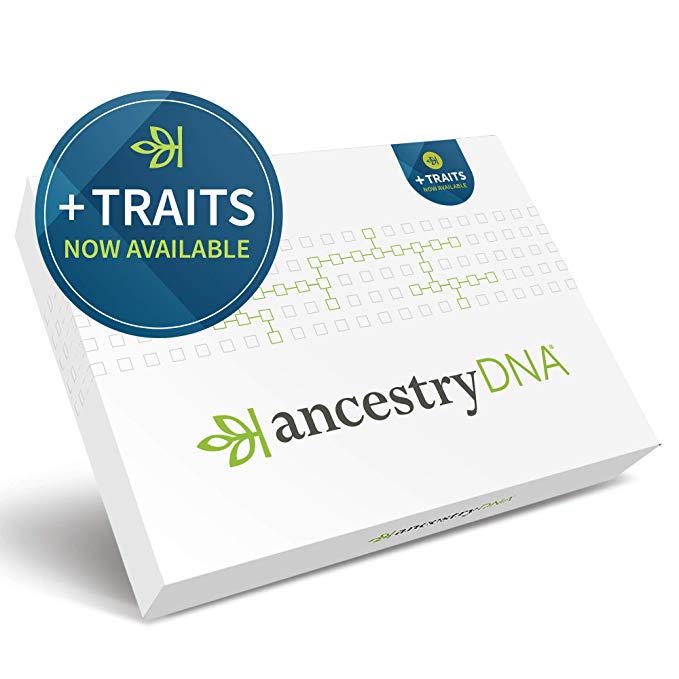 to allow only “invited guests” to your personal DNA party. (Read that post to be reminded why this is a good thing.)
to allow only “invited guests” to your personal DNA party. (Read that post to be reminded why this is a good thing.)
Ancestry has officially announced the launch of this feature update and reports that on average users will see an 80% reduction in the number of matches shown. I had a chance to look at the new site before it launched and one of my favorite features is the question mark that appears next to your match. Clicking on the question mark on your match page will bring up a menu of references to help you better understand the inner workings of matching at Ancestry, including those confidence levels that are a part of every relationship prediction. In this table below you can see that ancestry has tried to give you some fairly solid guidelines by which to assess the quality of your matches. You will want to focus on those matches with a confidence score of “High” or above to have the best chance of genealogical success. 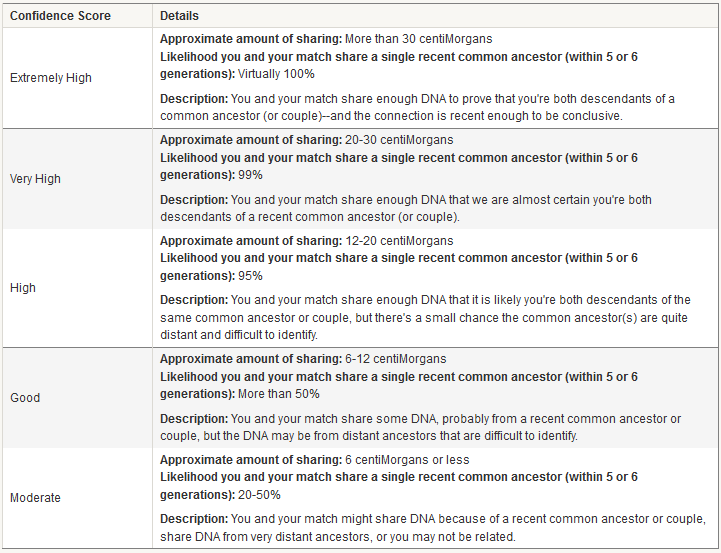 But an update to the matching feature is only the beginning of the new features at AncestryDNA
But an update to the matching feature is only the beginning of the new features at AncestryDNA . Today Ancestry announced “DNA Circles,” a tool that helps you identify others who share common ancestors with you. The new “DNA Circles” feature has the potential to impact the way you do genetic genealogy at Ancestry. Here’s why: Autosomal DNA (the kind that Ancestry is testing) has a spotty inheritance pattern. On average we only have half of the DNA of each of our parents, only 25% of our grandparents, only 12.5% of our great grandparents and so on. This means that AncestryDNA and its competitors (Family Tree DNA and 23andMe) are only able to genetically identify 50% of your genetic 4th cousins. This means that there could be 50% MORE people in these databases that you are actually related to, people that should have been invited to your DNA party, but didn’t have a ticket. Now with DNA Circles, there is a metaphorical “after-party.” After parties are “hosted” by one of your relatives. Ancestry searches your pedigree and that of your matches back 7 generations looking for suitable hosts. An ancestor qualifies as a host if they have two or more descendants who hold an invitation. At this after-party you can meet some of these long lost cousins that, while related to you, lost their ticket to your DNA party. After-party invitations are provided to those who meet three very important qualifications:
. Today Ancestry announced “DNA Circles,” a tool that helps you identify others who share common ancestors with you. The new “DNA Circles” feature has the potential to impact the way you do genetic genealogy at Ancestry. Here’s why: Autosomal DNA (the kind that Ancestry is testing) has a spotty inheritance pattern. On average we only have half of the DNA of each of our parents, only 25% of our grandparents, only 12.5% of our great grandparents and so on. This means that AncestryDNA and its competitors (Family Tree DNA and 23andMe) are only able to genetically identify 50% of your genetic 4th cousins. This means that there could be 50% MORE people in these databases that you are actually related to, people that should have been invited to your DNA party, but didn’t have a ticket. Now with DNA Circles, there is a metaphorical “after-party.” After parties are “hosted” by one of your relatives. Ancestry searches your pedigree and that of your matches back 7 generations looking for suitable hosts. An ancestor qualifies as a host if they have two or more descendants who hold an invitation. At this after-party you can meet some of these long lost cousins that, while related to you, lost their ticket to your DNA party. After-party invitations are provided to those who meet three very important qualifications:
- They have their DNA attached to their PUBLIC family tree.
- AND that PUBLIC family tree has the name of the hosting ancestor on it.
- AND this person shares DNA with at least one other person who also meets the above two criteria.
Here’s an example. Below is an image of the new AncestryDNA home page. You can see I am a part of two DNA Circles (some of you will be much more popular and invited to several after-parties. For me–just the two for now). Let’s take a closer look at my DNA Circle hosted by my paternal 5th great grandfather Minus Griggs (who knew the guy liked parties?!). 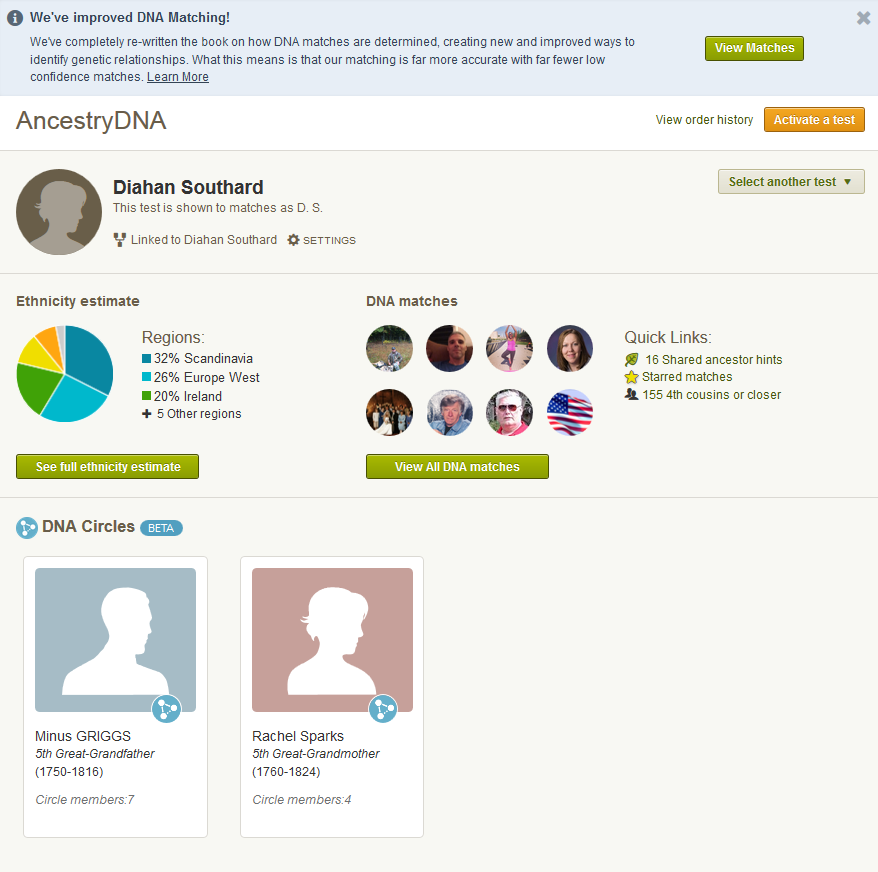 Clicking on the DNA circle brings up this page where there are three things I want to show you:
Clicking on the DNA circle brings up this page where there are three things I want to show you: 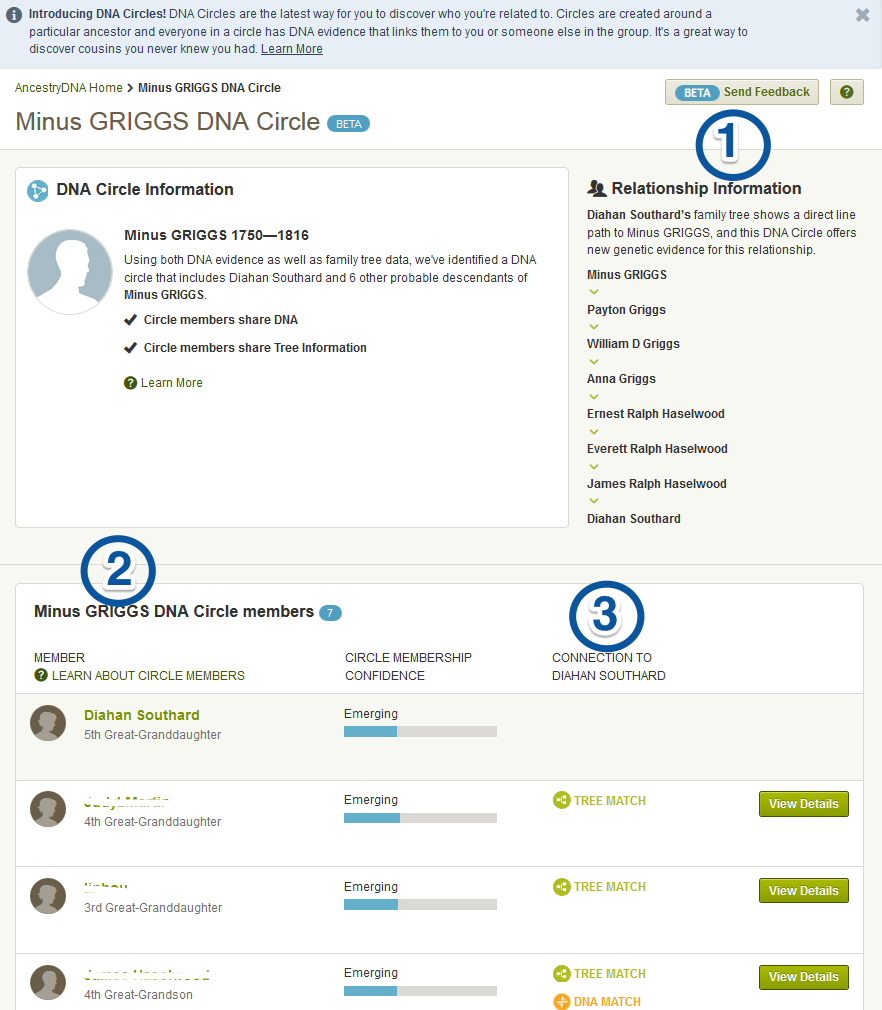
- This is your relationship to the host.
- This is a list of the individuals who have passed the three criteria listed above and have been invited to this after-party.
- This is the innovative part. You see that the first two matches (after me–I am listed first) have only “Tree Match” in this column. This means that these two people, both descendants of our host, Minus Griggs, didn’t ever appear on my DNA match list. We do not share enough DNA to be considered genetic relatives. However, the third member of the circle has the “DNA Match” designation, meaning that this match DOES appear on my match page. In fact, this is my ONLY DNA match in the circle (there are three others not shown here). That means that this DNA circle has connected me to FIVE other cousins. All because I share DNA and genealogy with the third member of this circle, and he shares DNA and genealogy with everyone else.
I can click on each circle member to see exactly how Ancestry THINKS we are related. This is my first opportunity to DOUBLE CHECK this relationship that Ancestry has handed me, to be sure that both my match and I really did receive tickets to the same after party.
Here is what that page looks like for me and one of my matches.
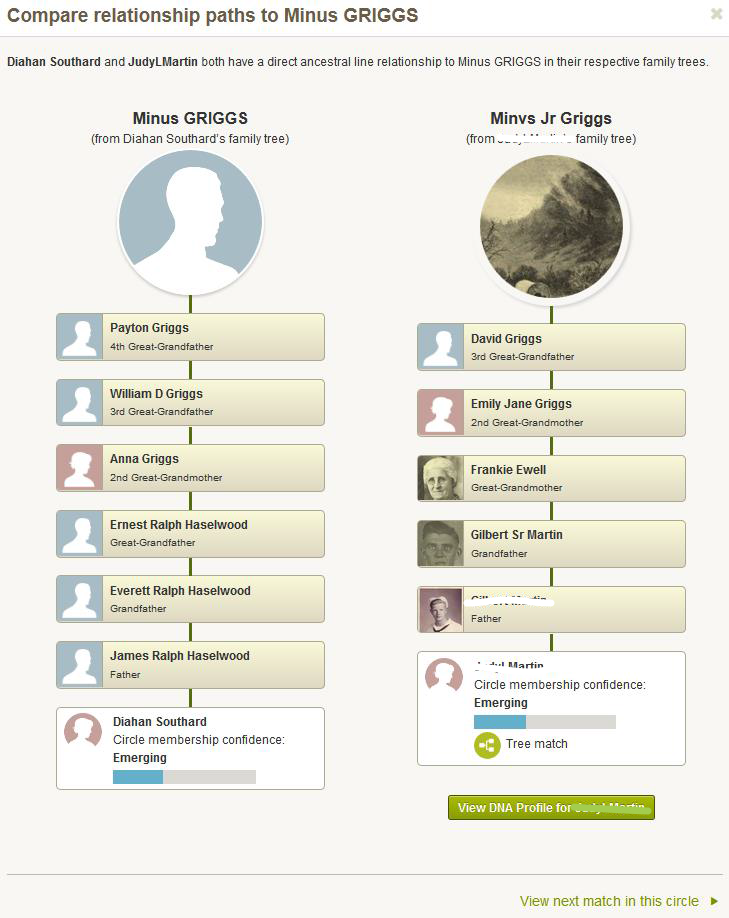 This is really the first time a DNA testing company has so fully integrated genetics and genealogy. We can now find cousins in the database who do not share our particular genetics, but who do share some of the genetics of our common ancestor. In my opinion, this is huge.
This is really the first time a DNA testing company has so fully integrated genetics and genealogy. We can now find cousins in the database who do not share our particular genetics, but who do share some of the genetics of our common ancestor. In my opinion, this is huge.
There is one catch, and it is going to be a big one for some of you. In order to see your DNA Circles, you have to be an Ancestry.com subscriber.
Even though I am excited about these changes, I can’t help but hope for just one step more. In order to identify these DNA Circles, Ancestry has identified pieces of DNA that can be fairly reliably assigned to a particular ancestor. There are likely others in the Ancestry database who have these pieces of DNA, we can call them partial tickets to the after-party, but who are lacking the second requirement: a pedigree documenting a relationship to that ancestor. I hope in the future the folks at Ancestry will honor those partial ticket holders, and allow them to the after-party, so we can sit around with our peanuts and pretzels and figure out how we are all related. Until then, I am going to enjoy the two after-parties hosted by my two generous ancestors.
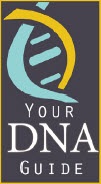 Ready to walk through the process of using DNA for your genealogy? Let me be your guide! Check out my quick
Ready to walk through the process of using DNA for your genealogy? Let me be your guide! Check out my quick 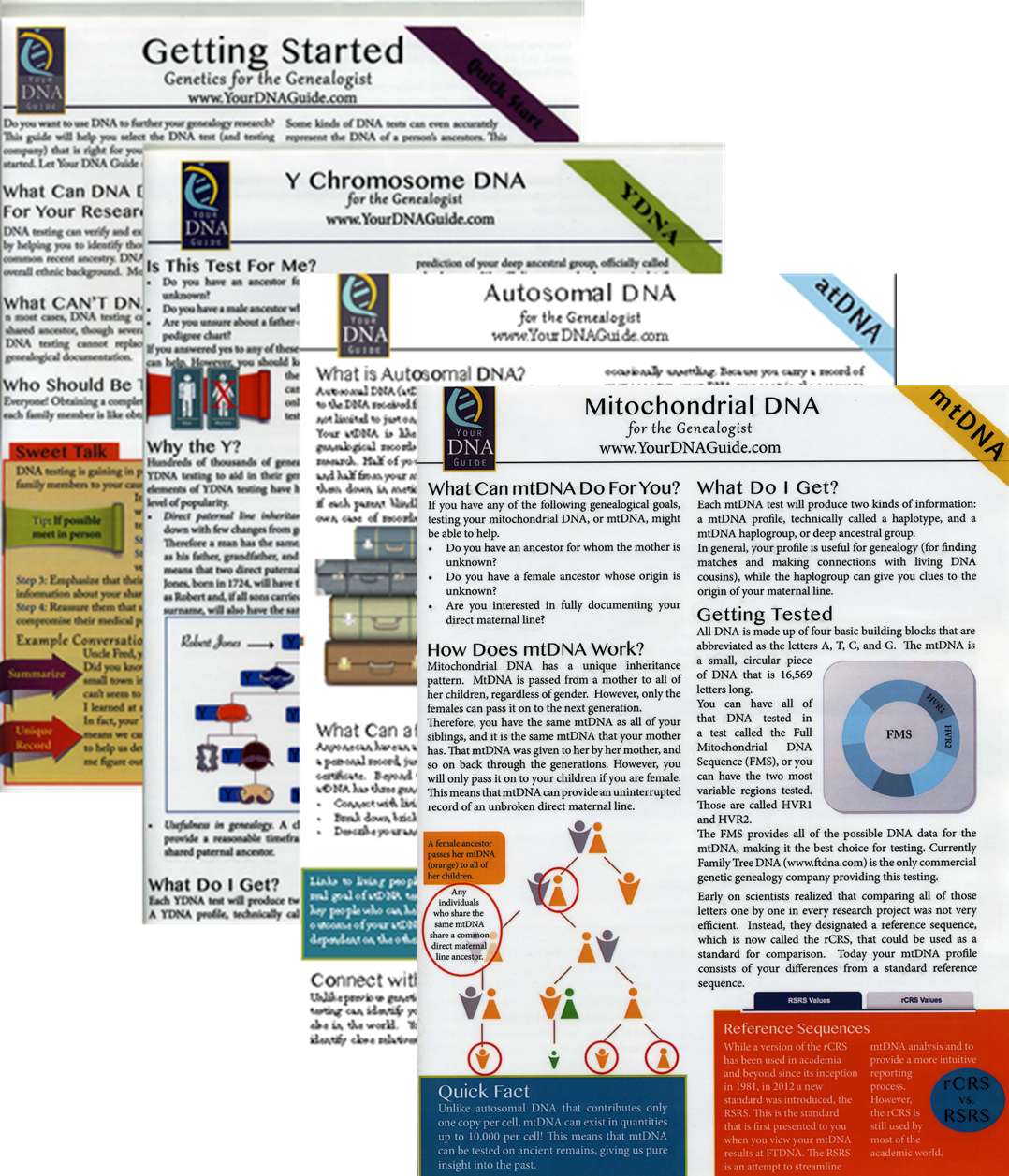 guides (left) Purchase each guide individually or pick up the bundle of all 4 for the best deal!
guides (left) Purchase each guide individually or pick up the bundle of all 4 for the best deal!
Visit my website to learn about expert consultations with me. You’ll get customized guidance on which tests to order and how to maximize your results for your genealogy research.
Page 5 of 6« First«...23456»
is blowing my genealogy mysteries wide open!
 Let’s say you have a second cousin, Denise, that you have already identified in the Ancestry database and you know your common ancestral couple is Joseph and Louise Mitchell. You want to gather others who share DNA with both you and Denise. Those individuals then have a high likelihood of being related to Joseph and Louise in some way.
Let’s say you have a second cousin, Denise, that you have already identified in the Ancestry database and you know your common ancestral couple is Joseph and Louise Mitchell. You want to gather others who share DNA with both you and Denise. Those individuals then have a high likelihood of being related to Joseph and Louise in some way. But what about Spencer? Spencer, unfortunately has not yet linked his family tree to his Ancestry account or answered any of your queries about his family tree. I am sure he has just been busy. Or he doesn’t know his family tree. Or his computer was captured by aliens or smashed by his two-year-old grandson just as he was about to click “send” and reveal how the two of you were connected. Whatever the case may be, up until this point you haven’t heard a peep from Spencer and therefore had absolutely no way to figure out how Spencer was related to you.
But what about Spencer? Spencer, unfortunately has not yet linked his family tree to his Ancestry account or answered any of your queries about his family tree. I am sure he has just been busy. Or he doesn’t know his family tree. Or his computer was captured by aliens or smashed by his two-year-old grandson just as he was about to click “send” and reveal how the two of you were connected. Whatever the case may be, up until this point you haven’t heard a peep from Spencer and therefore had absolutely no way to figure out how Spencer was related to you. If you’ve decided you would like to get in the DNA game, start with Ancestry DNA: Genetic Testing – DNA Test
If you’ve decided you would like to get in the DNA game, start with Ancestry DNA: Genetic Testing – DNA Test, and then head over to AncestryDNA and start growing your genetic family tree!











 to allow only “invited guests” to your personal DNA party. (
to allow only “invited guests” to your personal DNA party. (


 This is really the first time a DNA testing company has so fully integrated genetics and genealogy. We can now find cousins in the database who do not share our particular genetics, but who do share some of the genetics of our common ancestor. In my opinion, this is huge.
This is really the first time a DNA testing company has so fully integrated genetics and genealogy. We can now find cousins in the database who do not share our particular genetics, but who do share some of the genetics of our common ancestor. In my opinion, this is huge. 
 guides (left) Purchase each guide individually or pick up the
guides (left) Purchase each guide individually or pick up the 


